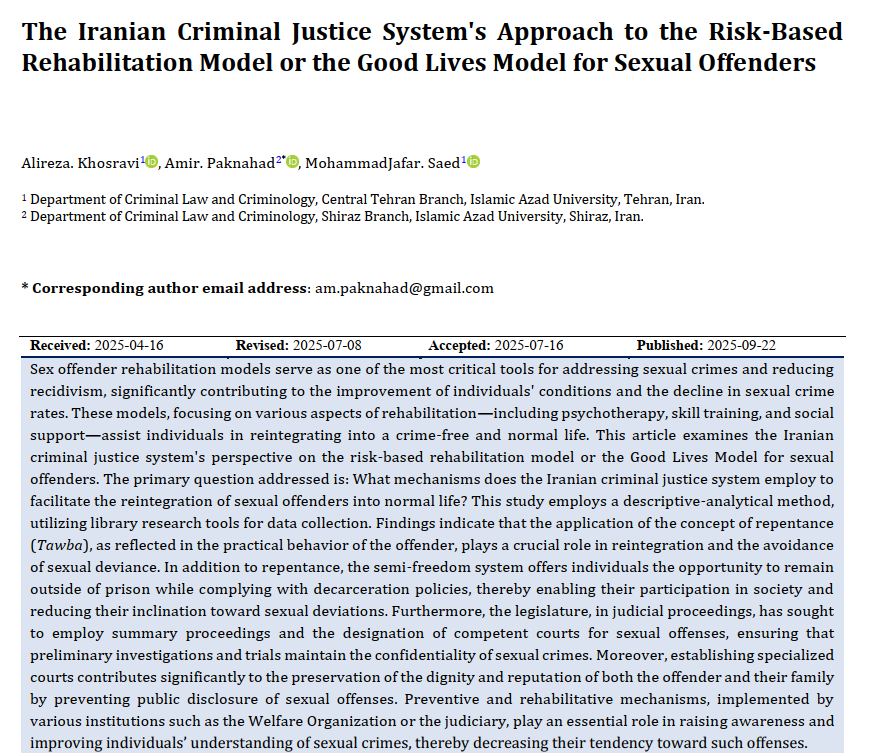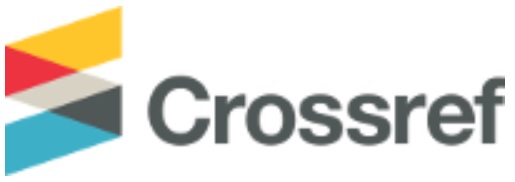The Iranian Criminal Justice System's Approach to the Risk-Based Rehabilitation Model or the Good Lives Model for Sexual Offenders
Keywords:
Sexual offender, sexual delinquency, rehabilitation, offender correction, criminal justice systemAbstract
Sex offender rehabilitation models serve as one of the most critical tools for addressing sexual crimes and reducing recidivism, significantly contributing to the improvement of individuals' conditions and the decline in sexual crime rates. These models, focusing on various aspects of rehabilitation—including psychotherapy, skill training, and social support—assist individuals in reintegrating into a crime-free and normal life. This article examines the Iranian criminal justice system's perspective on the risk-based rehabilitation model or the Good Lives Model for sexual offenders. The primary question addressed is: What mechanisms does the Iranian criminal justice system employ to facilitate the reintegration of sexual offenders into normal life? This study employs a descriptive-analytical method, utilizing library research tools for data collection. Findings indicate that the application of the concept of repentance (Tawba), as reflected in the practical behavior of the offender, plays a crucial role in reintegration and the avoidance of sexual deviance. In addition to repentance, the semi-freedom system offers individuals the opportunity to remain outside of prison while complying with decarceration policies, thereby enabling their participation in society and reducing their inclination toward sexual deviations. Furthermore, the legislature, in judicial proceedings, has sought to employ summary proceedings and the designation of competent courts for sexual offenses, ensuring that preliminary investigations and trials maintain the confidentiality of sexual crimes. Moreover, establishing specialized courts contributes significantly to the preservation of the dignity and reputation of both the offender and their family by preventing public disclosure of sexual offenses. Preventive and rehabilitative mechanisms, implemented by various institutions such as the Welfare Organization or the judiciary, play an essential role in raising awareness and improving individuals’ understanding of sexual crimes, thereby decreasing their tendency toward such offenses.
Downloads
References
Afshari Poor, G. (2015). International Licensing Agreements Pardis University of Qom]. Qom.
Ansari, M. (2015). International Licensing Agreement for Technology (Patent Rights, Trademarks, and Know-How). Hawzah and University Journal, 11(44), 81-106.
Baqeri, M., & Godarzi, M. (2019). A Comparison of the Protective Systems for Trade Secrets and Patent Systems. Law Quarterly, 39(1), 41-62.
Byrne, N., & McBratney, A. (2015). Licensing Technology: Negotiating and Drafting Technology Transfer Agreements. Jordans Publishing.
Dashti, V. (2007). Principles and Fundamentals of Technology Transfer with Turkey through Licensing Agreements Imam Sadiq University (AS)]. Tehran.
Devlin, A. (2010). The Misunderstood Function of Disclosure in Patent Law. Harvard Journal of Law & Technology, 23(2), 137-163.
Doak, B. R. (2015). Foreign Investment Disputes Cases Materials and Commentary Klumer Law International. Cambridge University Press.
Durham, A. L. (2019). Patent Law Essentials: A Concise Guide. Praeger. https://doi.org/10.5040/9798400695513
Fine, F. L. (2016). The EC Competition Law on Technology Licensing. Sweet and Maxwell.
Fromer, J. C. (2018). The Layers of Obviousness in Patent Law. Harvard Journal of Law & Technology, 22(1), 170-203.
Habibian, S. (2014). Iran's Patent System After the Acceptance of the Agreement on Trade-Related Aspects of Intellectual Property Rights. Faculty of Law and Political Science Journal, University of Tehran, 45(66), 145-182.
Hekmatnia, M. (2017). Fundamentals of Intellectual Property. Research Institute for Culture and Islamic Thought.
Jacob, S. R., Daniel, A., & Lindsay, L. (2017). Intellectual Property Translated by Hamid Hashem Beigi. Jihad University Publications.
Jafarzadeh, M., & Mahmoudi, A. (2016). International Patent Registration System (Contexts and Necessities). Legal Research Journal, 9(44), 55-108.
Lennon, M. J. (2017). Drafting Technology Patent License Agreement. Aspen Publishers.
Mackentz, R. (2014). Drafting and Implementing Technology License Agreements Translated by Seyed Kamran Baqeri. Industrial Center Publishing.
Miao, F. (2017). Protection of Intellectual Property Rights in Software Products and How to Accomplish a Technology Transfer Transaction in China. Journal of Fordham University School of Law, 26(3), 1-30.
Mirhosseini, S. H. (2016). Industrial Designs Law. Mizan Publications.
Moradi, Z. (2009). Abuse of Patent Certificates. Quarterly Journal of Global Trade Research, 4-5(16-17), 28-57.
Petherbridge, L., & Wagner, R. P. (2017). The Federal Circuit and Patentability: An Empirical Assessment of the Law of Obviousness. Journal of Texas Law Review, 85(3-6), 66-314.
Poltorak, A. I., & Lerner, P. J. (2018). Essentials of Licensing Intellectual Properties. John Wiley and Sons.
Saberi, R. (2008). Licensing Agreements. ShahreDanesh Publications.
Salehi Zahabi, J. (2009). Patent Rights (A Comparative View). Company Publications.
Saunders, K. M. (2020). Patent Nonuse and the Role of Public Interest as a Deterrent to Technology Suppression. Harvard Journal of Law & Technology, 15(2), 165-315.
Sidorova, I., & Brown, M. (2018). Patent and Trade Mark License Agreement under French Law. Anonymous Publications.
Stim, R. (2018). Licensing Your Invention. Nolo Press Bk & Disk Edition.
WIPO. (2004). Intellectual Property Handbook: Policy, Law, and Use. WIPO Publications.

Downloads
Additional Files
Published
Submitted
Revised
Accepted
Issue
Section
License
Copyright (c) 2025 Alireza Khosravi, Amir Paknahad, MohammadJafar Saed (Author)

This work is licensed under a Creative Commons Attribution-NonCommercial 4.0 International License.





